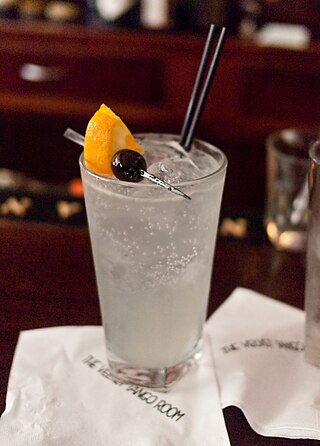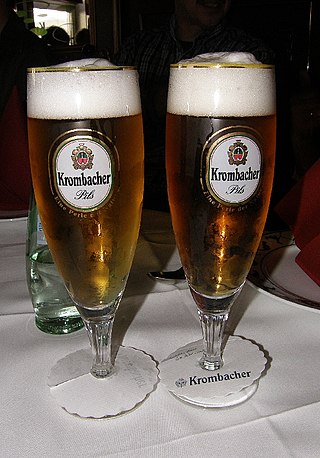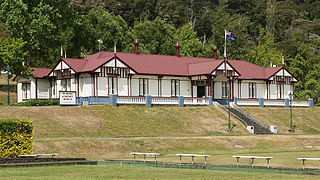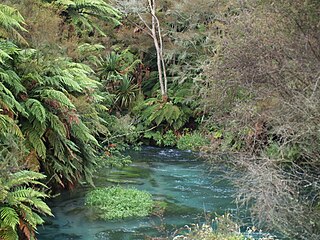Related Research Articles

A soft drink is any water-based flavored drink, usually but not necessarily carbonated, and typically including added sweetener. Flavors used can be natural or artificial. The sweetener may be a sugar, high-fructose corn syrup, fruit juice, a sugar substitute, or some combination of these. Soft drinks may also contain caffeine, colorings, preservatives and other ingredients.

The Tom Collins is a Collins cocktail made from gin, lemon juice, sugar, and carbonated water. First memorialized in writing in 1876 by Jerry Thomas, "the father of American mixology", this "gin and sparkling lemonade" drink is typically served in a Collins glass over ice. A non-alcoholic "Collins mix" mixer is produced, enjoyed by some as a soft drink.

Shandy is beer or cider mixed with a lemon or a lemon-lime flavored beverage. The citrus beverage, often called lemonade, may or may not be carbonated. The proportions of the two ingredients are adjusted to taste but are usually half lemonade and half beer/cider, resulting in a lower ABV for the finished drink. Shandies are popular in the UK, Europe, Australia, New Zealand, South Africa, and Canada.

Carbonated water is water containing dissolved carbon dioxide gas, either artificially injected under pressure or occurring due to natural geological processes. Carbonation causes small bubbles to form, giving the water an effervescent quality. Common forms include sparkling natural mineral water, club soda, and commercially produced sparkling water.

Kiwiana are certain items and icons from New Zealand's heritage, especially from around the middle of the 20th century, that are seen as representing iconic New Zealand elements. These "quirky things that contribute to a sense of nationhood" include both genuine cultural icons and kitsch.
Paeroa is a town in the Hauraki District of the Waikato Region in the North Island of New Zealand. Located at the base of the Coromandel Peninsula, it is close to the junction of the Waihou River and Ohinemuri River, and is approximately 20 kilometres south of the Firth of Thames.

Lemon & Paeroa, often shortened to L&P, is a sweet, lemon-flavoured soft drink manufactured in New Zealand. The drink is considered Kiwiana, and was traditionally made by combining lemon juice with naturally carbonated mineral water from the town of Paeroa. Today, it is manufactured by multi-national Coca-Cola. The origin date of the drink is uncertain, but the brand estimates 1907.

Te Aroha is a rural town in the Waikato region of New Zealand with a population of 3,906 people in the 2013 census, an increase of 138 people since 2006. It is 53 km (33 mi) northeast of Hamilton and 50 km (31 mi) south of Thames. It sits at the foot of 952 metres (3,123 ft) Mount Te Aroha, the highest point in the Kaimai Range.

The Waihou River is located in the northern North Island of New Zealand. Its former name, Thames River, was bestowed by Captain James Cook in November 1769, when he explored 14 mi (23 km) of the river from the mouth. An older Māori name was "Wai Kahou Rounga". A 1947 Geographic Board enquiry ruled that the official name would be Waihou.

Foxton Fizz is the name of a soft drink produced in Foxton and New Zealand on the North Island.

The phrase "world famous in New Zealand" is a commonly used phrase within New Zealand and the slogan of Lemon & Paeroa soft drink, coined by the British advertising agency Saatchi and Saatchi in 1993. It is used to describe items that though famous within New Zealand are unknown in the rest of the world, whereas similar items and people in larger countries would have a far higher media profile and would therefore be famous worldwide.

A "fizz" is a mixed drink variation on the older sours family of cocktail. Its defining features are an acidic juice and carbonated water. It typically includes gin or rum as its alcoholic ingredient.

Hikutaia is a locality on the Hauraki Plains of New Zealand. It lies on State Highway 26, south east of Thames and north of Paeroa. The Hikutaia River runs from the Coromandel Range through the area to join the Waihou River.

The Thames Branch railway line connected Thames, New Zealand, with Hamilton and was originally part of the East Coast Main Trunk railway. Part of the line between Morrinsville and Waitoa remains open and is in use as the Waitoa Branch line, connecting to the Fonterra Dairy Factory at Waitoa.

The Big Lemon & Paeroa Bottle is a statue of a bottle of the Lemon & Paeroa soft drink. It is located in Paeroa, New Zealand, where the drink was originally made. It is one of New Zealand's most famous icons, making it one of the most photographed places in the country. It has a height of 6.8 metres (22 ft), a diameter of 1.3 metres (4.3 ft), is made from concrete rings, and is surrounded by lemon trees and lemon shaped rubbish bins in a park around the statue. It is a popular tourist site, and the statue is owned by the council, but the branding and maintenance of the bottle is done by Coca-Cola Europacific Partners.
References
- 1 2 3 4 5 6 Rolleston, Te Aorewa (28 June 2022). "In a Fizz – Lemon and Te Aroha back to reclaim its soda crown". Stuff. Retrieved 30 October 2023.
- 1 2 3 4 5 "Lemon & Te Aroha – the return of NZ's original lemon soda". RNZ. 30 June 2022. Retrieved 30 October 2023.
- 1 2 3 Hope, Sharnae (5 January 2020). "New Zealand's first Kiwi fizz wasn't L&P but Te Aroha and Lemon". Stuff. Retrieved 31 October 2023.